What turn did you win your last game on?
The decks we choose, and the cards in those decks, interact across the turns in ways that we don’t always think about in any depth. Today, I’m going to do a bit of a breakdown of each of the major decks in Standard with an eye toward giving us more information that will let us decide which deck we want to play, how we might tweak our decks, and what the fundamental pace of the metagame is.
Before that, I’ll do a very quick check in on the current Standard metagame.
So, how about Standard?
There’s a lot of content down below, so this will be a relatively quick pass through the current state of Standard. This time around, I’m leaving those 3-1 Daily decks alone, focusing instead on Daily 4-0s and the Top 8s of seven different, big events (as always, those are a mix of paper and online events). That means today’s roundup was culled from some 56 Premier Top 8ing decks and 209 Daily 4-0s.
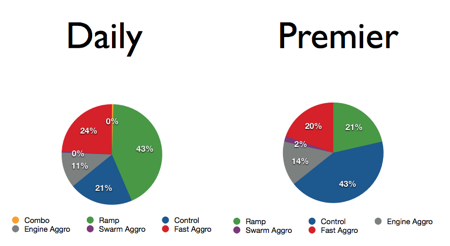
The Dailies continues to show a giant flood of ramp decks, comprising an even higher percentage of the metagame than they did
last week.
This upswing comes largely on the back of a decrease in the total percentage of the metagame being occupied by control decks.
The total slice of the metagame devoted to Aggro has remained largely the same since last time with the juggling entirely occurring within the Aggro pool, as this week saw an upswing in Fast Aggro and a moderate downside in “Engine Aggro,” the category that mostly comprises Vampire decks – specifically B/R Vampires.
On the other hand, check out those big-event Top 8s. Ramp and Control have simply swapped positions. Why would that be?
Here’s a more detailed view, looking at major deck archetypes:
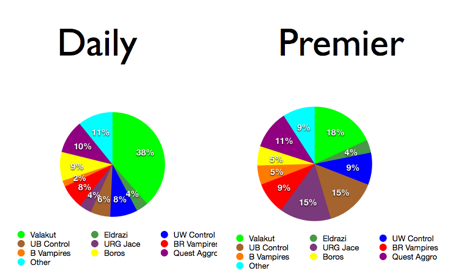
When we get to this level of detail, I find this kind of visual actually pretty hard to use. Here’s another way to look at it:
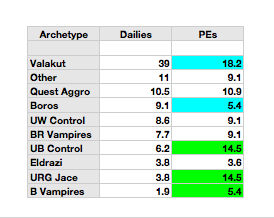
Those numbers are percentages of the metagame for each deck. On the PE (Premier Event – all those big ones) side, entries marked in blue showed a major decrease in percent of the metagame, and entries in green showed a major increase.
Notably, Valakut did far less well in terms of Premier-level appearances than in terms of Daily 4-0s. On the other hand, U/B Control, U/R/G Jace, and B/R Vampires decks are heavily enriched as we go into Premier Events.
As I’ll discuss below, I think there are some reasons beyond “Jace is pricey” for us to see more Jace decks doing well in Premier Top 8s.
From the perspective of going into a new event, I think it’s reasonable to say that you must be able to handle Valakut in the early rounds and all manner of Control decks in the late rounds – assuming you do well enough to face them.
The pace of your game
A few weeks ago, I
previewed the idea of abstraction
as a tool in understanding decks. This week, I’m going to pick apart the major archetypes in Standard right now with an eye toward understand how they tick.
There are a couple reasons we want to understand this kind of thing. First, it helps us decide if we really want to be playing a certain deck. Is it a good fit for the metagame in general? More pertinently, is it a good fit for the specific metagame where we’re going to deploy it? If you know your FNM is rife with Boros decks, it behooves you to understand how your deck choices may interact with that particular brand of shark tank. Second, it helps us understand how and why we might want to modify the deck – or not. If we understand, for example, that the Valakut game plan against aggro
requires
a suite of cheap, fast removal, then we’ll know not to cut that in favor of other cards that we appreciate in the abstract.
Breaking down a deck
As a quick refresher, the idea behind an abstraction is to take the cards in a deck and assign them to roles, then see how those roles are spread across the turns of a game. Thus, a Doom Blade is removal, and a Deathmark is also removal. A Cunning Sparkmage is simultaneously removal and a threat.
The turn that cards “turn on” depends on the deck’s acceleration. For the decks I’m highlighting today, this primarily impacts Valakut, which is so laden with acceleration that it’s a full two turns or so faster than its mana costs would suggest.
This week, I’m going at three factors in the decks in Standard – threats, removal, and disruption.
Threats are things that can close out a game – typically creatures but also pals like Koth and lands like Valakut. I’ve also added a category for reach spells – those spells that don’t quite qualify as threats on their own, but which can definitely close out a game, like Lightning Bolt.
Removal comes in two flavors, individual and mass removal, such as Doom Blade and Day of Judgment, respectively.
Disruption is a category that speaks to those cards that screw with an opponent’s game plan by methods other than killing their stuff. General disruption includes counterspells and discard. Aggro disruption covers things like Wall of Omens, Obstinate Baloth, and Into the Roil. Finally, there’s a special “bomb” disruption category for things that can specifically handle the bomb finishers that are prevalent in Standard. Act of Treason is a good example of this final category.
In evaluating decks this week, I’ve generated an “average” top performing version of the deck, much as I did
last week
for Valakut. Only this week, I’ve just smooshed all seventy-five cards from the maindeck and sideboard together with the logic that this most accurately represents the deck’s total game plan and gives us a good “worst-case scenario” to consider when deciding how we’re going to attack that specific matchup.
Here’s the average top-performing Valakut deck, broken down as described:
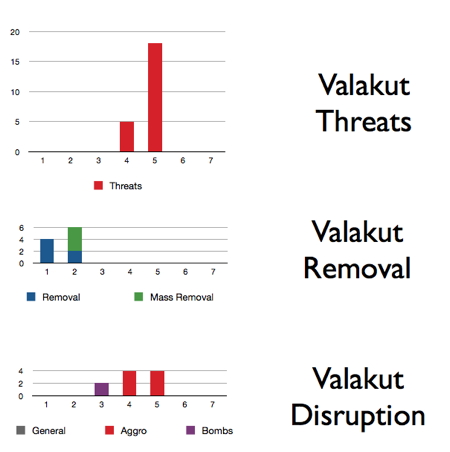
In other words, across many representative Valakut decks we have threats that can appear as early as turn 4 with all of them typically deployed by turn 5 (remember that this accounts for acceleration – obviously, Avenger of Zendikar still costs seven and can only attack a turn after you cast it… but acceleration can get us there much, much earlier). Our example Valakut decks also have about ten removal cards in their seventy-five, all deployable by turn 2, and have no generalized disruption, instead focusing on stifling aggro and bomb-oriented game plans.
Comparing decks with abstraction
Okay, so that’s one deck. How do we apply that to understanding the metagame?
Consider this comparison between the Boros threat schedule and the solutions in U/B Trinket Mage decks:
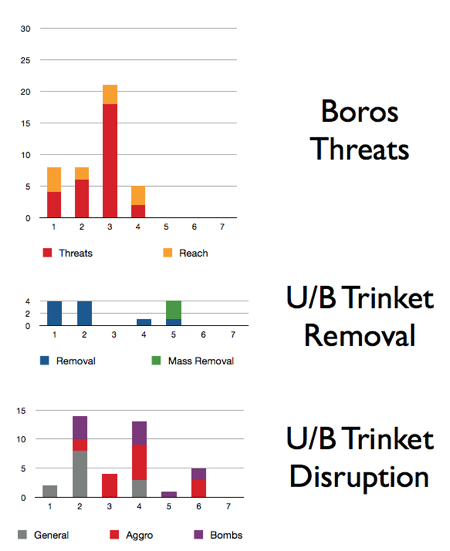
Hopefully, this makes the concept pretty clear.
Our typical Boros deck deploys threats starting from turn 1 (go, go Goblin Guide!) with a peak in the violence at turn 3. Incidentally, this is the turn the threat starts
attacking,
so that big peak on turn 3 represents a whole bunch of non-hasty two-drops such as Plated Geopede and Squadron Hawk, ready to swing in on turn 3.
At the same time, our typical U/B Trinket Mage deck has removal on turns 1 and 3, bolstered by a suite of generalized and aggro-oriented disruption effects spreading out from turn 2 onwards.
All in all, they seem pretty well matched, in a yin-yang kind of way.
Keep these things in mind as you check out the following charts and commentary.
Standard pacing, an archetype at a time
So, how does your favorite archetype play out?
I’m going to close out today’s piece by doing an archetype-by-archetype review of pacing in Standard, along with some commentary about what I think this means for the build, when we’d want to play it, and how we might want to tweak it – or not.
Valakut

Ah, Valakut. Still the prevalent deck in Standard, if not the dominant deck in the Top 8 of Premier Events.
As we saw last week, Valakut is a deck that is hellbent on sticking its threats, starting on turn 4 and then hitting like a tidal wave on turn 5. Of all the decks in Standard right now, Valakut is probably the most pure in intent – even more so than Quest Aggro, really.
Looking at that threat curve, the removal curve makes eminent sense. Most Valakut decks feature four Lightning Bolts in the main and four Pyroclasms in the side, with a little bit of additional removal available. The deck hopes to simply stave off ultra-fast attackers like Boros and Vampires long enough to let it start dropping threats.
Notice how Valakut’s aggro-oriented disruption suite
also
deploys on turn 4 at the earliest. When we take this in combination with the threat schedule, it suddenly becomes clear why the deck
requires
those early removal spells unless you’re confident that basically no one in the tournament will be running fast aggro. I’ve seen some players try to skimp on these elements in the hope of outrunning aggro, but once you see the curves, it’s clear that this is an unhealthy choice.
Typical Valakut decks also have no generalized disruption – in other words, almost nothing that interacts directly with control decks. Essentially, outside of the threat of Summoning Trap, Valakut hopes to have more threats than control has answers – a proposition that may not be working out well in the later rounds of big events.
U/B Control
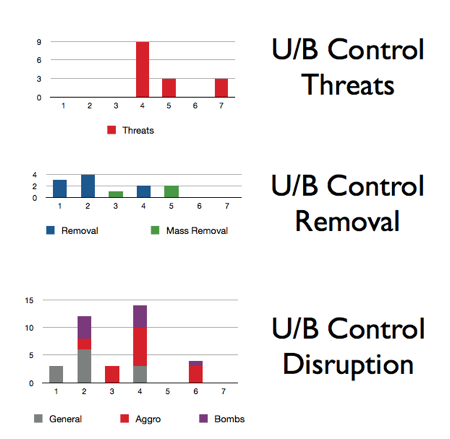
I’ve split the U/B archetype pool into decks with or without Trinket Mage, since they have distinct card choices.
Like Valakut, U/B Control doesn’t start deploying its threats until turn 4. Notably, it also doesn’t have nearly as many threats to work with – make sure to compare those column heights!
However, U/B Control does have a nice, steady progression of removal and disruption, starting from turn 1 for both. It’s kind of a trickle of removal, however, showing how this deck can potentially be overwhelmed, either by a surplus of threats from fast aggro or by its own clunky draws (where you draw all your Jaces and Frost Titans instead of your Mana Leaks and Doom Blade).
The deck has a lot of anti-bomb options available starting fairly early. This, in combination with having several turns to stockpile disruption and removal, highlights why U/B Control is an excellent choice if you happen to be in a ramp-heavy metagame.
It’s my impression that the relative paucity of mass removal – and the specificity of that removal – means that U/B Control can find itself in the position of being overwhelmed by fast aggro decks in the early game.
Here’s the Trinket Mage version:
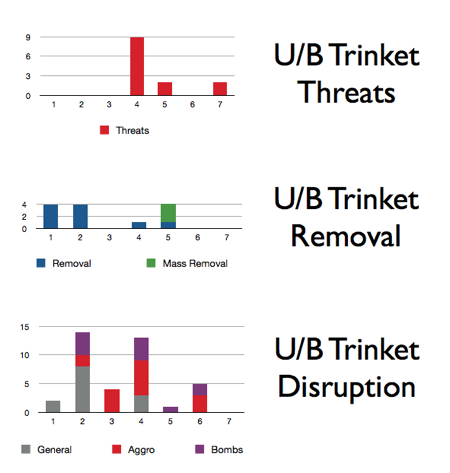
The profile here looks a lot like that Trinket-less version above, with a bit more of an emphasis on aggro opponents, and a skosh less general disruption.
It’s hard to abstract out the value of flexibility, which the Trinket Mage package provides. If I were to play U/B Control, I’d definitely go with the Trinket Mage version, both for the sake of flexibility and for my own love of tutoring up cards.
However, even with that added flexibility and a bit more of an anti-aggro angle, I think the U/B Trinket build is also limited in its ability to handle fast aggro.
So what
is
good at fighting fast aggro?
U/W Control
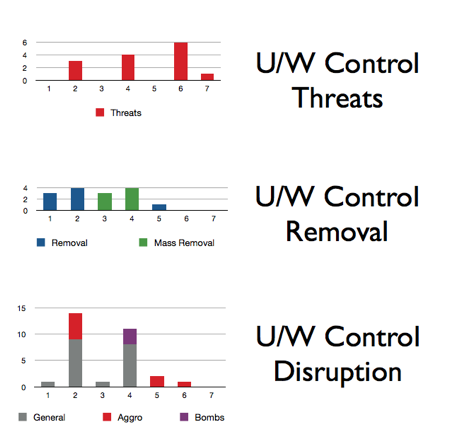
There you go.
Despite repeated claims that U/W Control is “bad” now – and we do love to make these sweeping, global statements – it has seen a recent upswing. I point the finger for this at the simultaneous upswing in B/R Vampires decks, with the premise that U/W Control is simply better against fast aggro.
Curiously, the average high-performing U/W deck runs out its threats much, much faster than U/B Control or even Valakut… although it has far fewer threats than Valakut. If you’re confused by those threats appearing on turn 2, they’re Luminarch Ascension, which is all over U/W decks these days. We might more properly want to put them on a later turn, as they won’t be online for another four… but the turn they come down is the turn that opposing decks must start trying to deal with them. This is a real issue for opposing control decks, which, as we’ve seen, don’t deploy their threats particularly quickly.
Like U/B Control, U/W Control decks don’t have an abundance of removal… although U/W Control has more. However, the big deal against fast aggro decks is the sheer abundance of fast, early removal. As much as Day of Judgment lacks the glamour of prior wrath effects, it still does plenty in terms of neutering incautious aggro players, or forcing good ones to slow down.
Relative to U/B Control, U/W builds tend to have less in the way of disruption aimed at things that have already made it onto the battlefield. However, they tend to be even more robust in terms of pure disruption in the form of countermagic. This classic U/W one-two punch of “counter your stuff, then finally kill whatever made it through” remains a good, robust choice… unless you’re dealing with a ramp deck that can run out one gigantic threat at a time while threatening to kill you with lands.
My preference right now would be to play U/W Control, based purely on how many fast aggro decks are racing around right now.
U/R/G Control
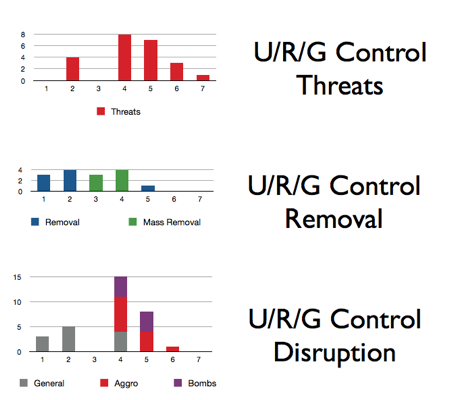
I vacillate between calling this “U/R/G Control” and “U/R/G Jace” – it’s not a pure control deck in the manner of the ones we’ve just seen.
First of all, check out that threat curve – that may well be half of what makes this deck so effective. As you may know from actually playing with or against the deck, it topdecks tremendously well, and a big part of that is having access to so many solid bomb threats.
It has a removal profile that’s similar to the U/B and U/W Control decks, with the major difference from those decks being that its non-removal solutions to opposing decks come online somewhat late. In fact, this deck is in many ways all about turn 4, where it can probably start dropping Frost Titans and other goodies to try and lock down the game.
The relative sparseness of cards in each category provides a bit of support for one idea I’ve had about the U/R/G Jace decks – they’re just hard to play properly. A properly built Jace deck has four copies of big Jace (naturally) and four copies of Preordain, giving its
pilot amazing access to the cards within the deck. Much as with Countertop decks in Legacy, this means that the deck can afford to get away with
some
removal and
some
disruption… as long as the pilot knows what they need and when.
The upshot is that the deck is powerful, but the corollary is that you really need practice. Based on its profile and considering its dependence on card selection, I wouldn’t recommend running U/R/G Jace unless you’ve had time to actually practice it in the relevant matchups.
Boros
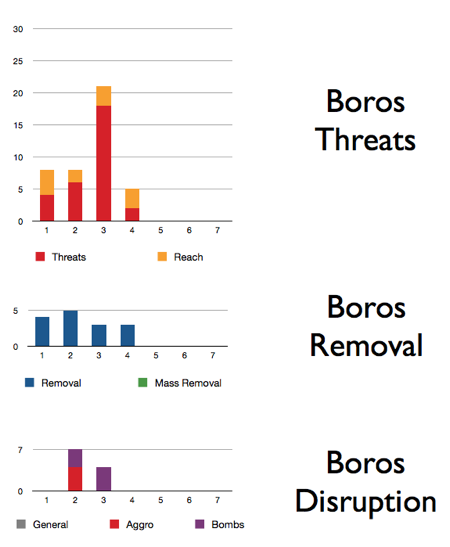
…And here are those early threats against which the Valakut deck is trying to survive.
I like the Boros deck for today’s metagame. It has a robust early threat suite, starting on turn 1 and peaking with a seemingly endless supply of two-drops, attacking on turn 3. This threat wave is backed by a pleasing supply of reach spells that let the deck finish off an opponent who may have, say, tapped out to play Day of Judgment or Avenger of Zendikar.
The Boros deck is also well equipped with removal, which gives it solid footing for the fight against other aggro builds.
The disruption suite is limited and largely focused on the second-biggest hole in the Boros game plan – giant, game-plan-shifting bombs.
So if Boros is so awesome, why isn’t it seeing more victories? My best guess is that Boros suffers from the same problem as those U/R/G Jace decks – it’s actually hard to play properly. If you’re of a mind to go “play my dudes, throw burn at your head,” then Boros will fail you more often than you’d like. Boros is versatile and resilient, but you’ll need to be able to play proper critters-n-burn Magic around a wall of Pyroclasms, Baloths, and Days.
B/R Vampires
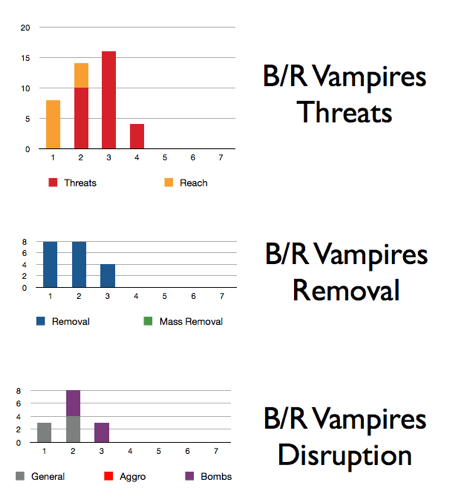
On the face of things, the B/R Vampires deck has a lot in common with Boros. It has a solid pulse of aggro from turn 2 through turn 4, as well as a bunch of removal and some anti-bomb cards.
However, this is one of those cases where the profile can be a little misleading.
The Boros deck’s removal includes a bunch of burn spells that you’d be playing
anyway.
On the other hand, much of the removal in B/R Vampires is purpose-built removal in the form of Doom Blade and such, meaning that you have to side something out to side that removal in, increasing the likelihood of having dead cards in hand from time to time.
On the other hand, Vampires offers an attacker-independent finishing move via Kalastria Highborn, which means that even if it’s less versatile in general, it’s easier to see the endgame.
If you were going to run an aggro deck but only had time to goldfish or test a little, I’d recommend B/R Vampires over Boros. I prefer Boros, but Vampires is simply less tricky to deal with as a player.
Quest Aggro
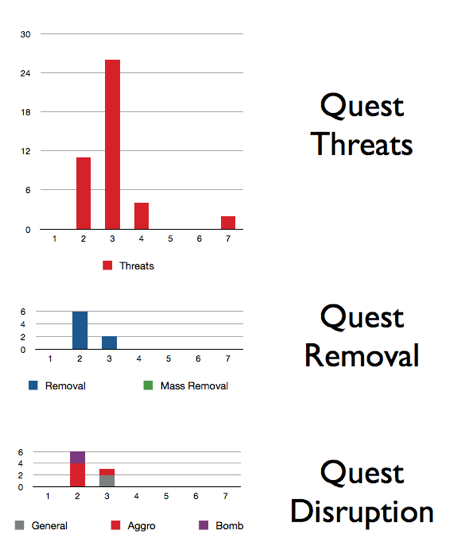
Yeah, I don’t like this deck.
Its essential purity is clear – if Valakut is about threats from turn 4 on, Quest Aggro is about threats from the get go. Unfortunately, that’s nearly
all
it’s about. The deck has modest removal and similarly limited disruption.
Or, to put it another way, if you don’t simply run your opponent down, your plan B is terrible.
Two weeks ago,
Brian Kibler called Quest a “gimmick deck,”
because it’s too easy to solve the main threat via Naturalize effects. Indeed, since then we’ve seen more and more Naturalize effects (Nature’s Claim, typically) in sideboards, ready to stuff the deck’s primary aggro plan.
The Quest Aggro deck is still winning, even at premier levels, but I wouldn’t want to play it because it’s just so very linear.
Metagame finale
So, my quick take-home is that Boros and U/R/G Jace are great decks, but you need to practice or they’ll fail you. If you have less time to prepare, I’d go for U/B or U/W on the control side and B/R Vampires on the aggro side. Valakut is passable but rather linear, and Quest Aggro is far too limited and inflexible to recommend as a solid choice.
In closing, I wanted to ask all of you to let me know what you’d like to see in terms of metagame tracking and analysis. Obviously, we always want to keep up with Standard, but I want to know if you’d like to see more about other formats. Legacy? Extended? Scars Block?
Let me know in the forums,
on Twitter,
or email me at magic (at) alexandershearer.com. I’ll look forward to hearing from you.
